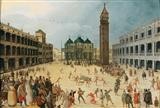Sebastiaen Vrancx
(Antwerp 1573–1647)
A carnival scene in Piazza San Marco, Venice,
oil on panel, 50 x 74 cm, framed
Provenance:
sale, Christie’s, London, 30 November 1979, lot 77 (as Louis de Caullery);
sale, Bruun Rasmussen, Copenhagen, 20 September 2016, lot 4 (as attributed to Louis de Caullery)
Literature:
M. A. Katritzky, Harlequin in Renaissance Pictures, in: Renaissance Studies 11, 1997, no. 4, pp. 406, 410–412, pl. 9 (as Sebastiaen Vrancx);
M. A. Katritzky, The Art of Commedia, A Study in the Commedia dell’Arte, 1560–1620, with special reference to the visual records, Amsterdam/New York 2006, pp. 129–139, pl. 125 (as Sebastiaen Vrancx);
M. A. Katritzky, German Patrons of Venetian Carnival Art: Archduke Ferdinand II of Tyrol’s Ambras Collections and the 1579 Travel Journal of Prince Ferdinand of Bavaria, in: B. U. Münch, A. Tacke, M. Herzog, S. Heudecker (eds.), ‘Von kurzer Dauer’, Fallbeispiele zu temporären Kunstzentren der Vormoderne, Petersberg 2016, pp. 126–142, pl. 2
Depictions of the Venetian carnival can already be found in the late sixteenth century and Flemish artists soon adopted these motifs. The present painting is an important and early example of such carnival pictures from Venice, featuring motifs of the Commedia dell’arte. The scene depicted by Vrancx shows a refined combination of traditional carnival motifs: the giovedí grasso bullfight, matachins with their large drums, acrobats, buffoni, a street theatre with a quack advertising his goods, and the familiar couple of Pantalone and Zanni. In the left foreground, a group of elegantly dressed bystanders observes the bullfight, among them possibly Archduke Ferdinand II of Tyrol and his nephew, Prince Ferdinand of Bavaria, with their entourage, whose journey to the carnival of Venice is documented as 1579.
The paintings of Piazza San Marco featuring carnival scenes by Sebastiaen Vrancx and similar works commonly attributed to Louis de Caullery (1579/81–1621), can be regarded as contributions to a newly established genre showcasing famous places in such Italian cities as Venice, Florence, and Rome. The architectural backdrops of these compositions merely serve to identify the respective towns and are not intended as precise topographical renderings. The present painting by Vrancx is one of the earliest examples of its kind. The Carnival in the Piazza San Marco can be dated to around 1605, as it betrays certain resemblances to Vrancx’s monogrammed painting Dives and Lazarus, which is known to have served as the basis for an engraving from 1606. Not only do the groups of comedians in both compositions exhibit strong similarities, but also details in the costumes, poses, and faces of the aristocratic audiences are entirely comparable. This suggests that both paintings can be identified as early works by Vrancx. With such compositions as the present painting, Vrancx paved the way for the grand Venetian views of the seventeenth and eighteenth centuries.
View it on
Estimate
Time, Location
Auction House
(Antwerp 1573–1647)
A carnival scene in Piazza San Marco, Venice,
oil on panel, 50 x 74 cm, framed
Provenance:
sale, Christie’s, London, 30 November 1979, lot 77 (as Louis de Caullery);
sale, Bruun Rasmussen, Copenhagen, 20 September 2016, lot 4 (as attributed to Louis de Caullery)
Literature:
M. A. Katritzky, Harlequin in Renaissance Pictures, in: Renaissance Studies 11, 1997, no. 4, pp. 406, 410–412, pl. 9 (as Sebastiaen Vrancx);
M. A. Katritzky, The Art of Commedia, A Study in the Commedia dell’Arte, 1560–1620, with special reference to the visual records, Amsterdam/New York 2006, pp. 129–139, pl. 125 (as Sebastiaen Vrancx);
M. A. Katritzky, German Patrons of Venetian Carnival Art: Archduke Ferdinand II of Tyrol’s Ambras Collections and the 1579 Travel Journal of Prince Ferdinand of Bavaria, in: B. U. Münch, A. Tacke, M. Herzog, S. Heudecker (eds.), ‘Von kurzer Dauer’, Fallbeispiele zu temporären Kunstzentren der Vormoderne, Petersberg 2016, pp. 126–142, pl. 2
Depictions of the Venetian carnival can already be found in the late sixteenth century and Flemish artists soon adopted these motifs. The present painting is an important and early example of such carnival pictures from Venice, featuring motifs of the Commedia dell’arte. The scene depicted by Vrancx shows a refined combination of traditional carnival motifs: the giovedí grasso bullfight, matachins with their large drums, acrobats, buffoni, a street theatre with a quack advertising his goods, and the familiar couple of Pantalone and Zanni. In the left foreground, a group of elegantly dressed bystanders observes the bullfight, among them possibly Archduke Ferdinand II of Tyrol and his nephew, Prince Ferdinand of Bavaria, with their entourage, whose journey to the carnival of Venice is documented as 1579.
The paintings of Piazza San Marco featuring carnival scenes by Sebastiaen Vrancx and similar works commonly attributed to Louis de Caullery (1579/81–1621), can be regarded as contributions to a newly established genre showcasing famous places in such Italian cities as Venice, Florence, and Rome. The architectural backdrops of these compositions merely serve to identify the respective towns and are not intended as precise topographical renderings. The present painting by Vrancx is one of the earliest examples of its kind. The Carnival in the Piazza San Marco can be dated to around 1605, as it betrays certain resemblances to Vrancx’s monogrammed painting Dives and Lazarus, which is known to have served as the basis for an engraving from 1606. Not only do the groups of comedians in both compositions exhibit strong similarities, but also details in the costumes, poses, and faces of the aristocratic audiences are entirely comparable. This suggests that both paintings can be identified as early works by Vrancx. With such compositions as the present painting, Vrancx paved the way for the grand Venetian views of the seventeenth and eighteenth centuries.



